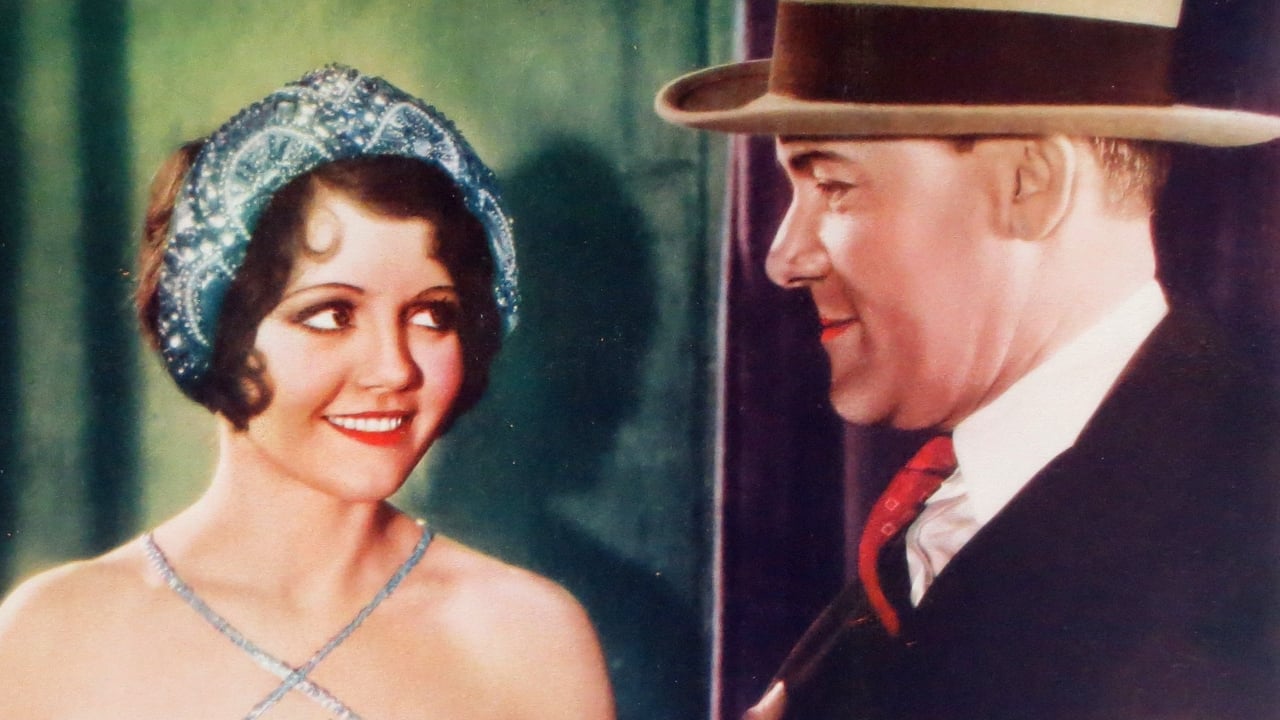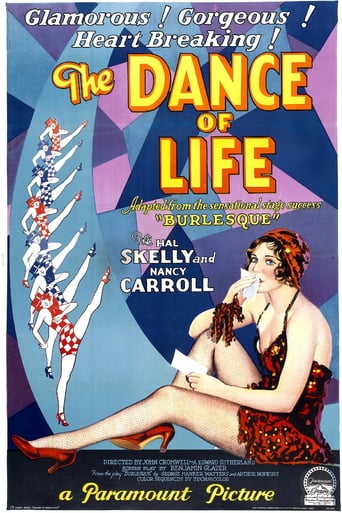Matialth
Good concept, poorly executed.
KnotStronger
This is a must-see and one of the best documentaries - and films - of this year.
Dirtylogy
It's funny, it's tense, it features two great performances from two actors and the director expertly creates a web of odd tension where you actually don't know what is happening for the majority of the run time.
Ava-Grace Willis
Story: It's very simple but honestly that is fine.
cstotlar-1
This was certainly not what I expected. I was delightfully surprised in just about every way. This film shows clearer than any I've seen the Vaudeville life and the acts in the last years. The sound was handled beautifully and the ending quite touching. Since I caught this where I could find it on You Tube, there were no sequences in color, alas, but everything else was precious, particularly the leads. It paved the way for so many subsequent "show must go on" movies and the phrase itself finally became cliché but this is pristine, sensitive and ultimately quite moving. I was also thankful that so many of the acts were filmed in their entirety, for historical as well as artistic reasons. The balance was perfect!Curtis Stotlar
eschetic-2
The famous play, BURLESQUE, came to Hollywood following a successful Broadway run (372 performances at the Plymouth Theatre from Sept. 1, 1927 through July of the following year made it one of the biggest hits of the year) just at the cusp of when burlesque - which George Jessel had described as "the most family friendly" theatre form as straight vaudeville declined - was itself declining from the fine mix of sketch comedy and music into the girlie shows that would be banned by Mayor LaGuardia in the 1940's. Paramount apparently felt that decline as well as the universal quality of the story merited the name change to THE DANCE OF LIFE for their August 16, 1929 film release, but they also knew well how famous the original play had become as it toured around the nation, so the original name was prominently featured in all the advertising.Protecting their investment further, four members of the original Broadway cast were recruited for the film version (the lead, Hal Skelly as "Skid", Ralph Theodore as Harvey, Charles D. Brown as Lefty and the great Oscar Levant in his first film role as Jerry the composer/pianist). Only the Broadway leading lady, Barbara Stanwyck as Bonny, Skid's lady love, was passed over for look-alike Nancy Carroll (rumor hath that Stanwyck's real life leading man declined to let her take the role unless he was hired too). Carroll was entirely fine in the role and Stanwyck followed to Hollywood shortly after.The result for THE DANCE OF LIFE was one of the year's best films and the script, direction and cinematography hold up remarkably well after a little over 80 years, much better than some of the early full fledged "musicals" filmed at the time. This was not a traditional "musical" by Broadway or Hollywood standards, but a play in which a lot of music was intrinsic to the plot, and the musical numbers are as good a snapshot of what real live touring musical theatre looked like in 1929 as many an actual filmed musical show (like the Marx Brothers' COCOANUTS which was filmed at the end of its "subway circuit" tour out at the Astoria Studios in Astoria, Queens, New York). The borderline "beef trust" chorus girls marching in unison are a far cry from modern "choreography," but they breathe with the life of the world portrayed.As good as the film is - and it is very good indeed, despite the often copied plot, remarkably faithful to the Broadway original, of the loyal girl protecting her talented but weak partner - no small credit is due to the superior cast. An Oscar Levant younger than most people today know him from his film roles of ten to twenty years later (THE BAND WAGON, opposite Nanette Fabray passing for a composer/lyricist team patterned after Betty Comden and Adolph Green is a classic), gives every indication of the indelible comic curmudgeon he would become, and Hal Skelly's Skid is a leading character actor for the ages. "Skid" would be a great performance in any age.I haven't seen a naturalistic performance jump out of the more declamatory style performances around it with this much vivacity since Helen Hayes opposite Gary Cooper (three years later) in A FAREWELL TO ARMS. Hayes, of course, would go on to a brilliant career on stage and screen for another 50 years. Skelly might have, but after only a few more films and Broadway shows, while back East producing and starring in one of them (the ironically titled COME WHAT MAY) he lost his life when a car he was riding in was hit by a freight train in Connecticut. It was a greater loss to the stage and screen than those who have never seen his performance in this film (BURLESQUE was, with good reason, his greatest hit) can ever fathom.I've never been able to find a copy of the brief VHS release noted elsewhere of the Paramount Picture, but until some wise soul finds a way to pry a pristine copy from the Paramount archives (one suspects the film may now be in the public domain if ANY copy could be found) to make it available to a new generation of film and theatre students who need to see the craft and passion involved, at least a decent copy can be viewed at Archive.org. It is essential viewing for any true student of the theatre or film. I'll be first in line to buy a copy when a DVD is available. Let's hope it's soon.
kidboots
When John Cromwell was hired to direct "The Dance of Life", a film version of the Broadway success "Burlesque", it was automatically assumed that the key members of the cast would be tested and hired. They all turned up for a one act screen test - all except one. Barbara Stanwyck's husband refused to let his wife do the film (according to Oscar Levant). He was an egomaniac and wouldn't let her go to Hollywood until he was also summoned (Stanwyck made her film debut a few months later in the static "The Locked Door"). So the assignment was given to Paramount's latest star Nancy Carroll - she was not only more relaxed and natural in front of the cameras than many of the other "stagies" in the film, she definitely boosted the film's popularity at the box office.Skid Johnson (Hal Skelly), a talented comedian, who is also an alcoholic, is fired from a third rate burlesque show. He meets Bonny Kane (Nancy Carroll) who has failed to make specialty dancer from the same show. "You wouldn't kid me lady? I would if I could mister, I would if I could" - that became a popular catch phrase of the day. They become friends and get jobs in the same show. Under Skid's guidance Bonny becomes an expert dancer and through her steadying influence he really starts applying himself to his work.Someone else has their eye on him -Sylvia (beautiful Dorothy Reiver). Skid performs "King of Jazzmania with the chorus then Bonny takes the stage for "Cuddlesome Baby". The manager wants to get rid of Bonny but Skid persuades him to keep her and deduct her wage from his salary. She finds out and decides to quit but in the middle of their routine Skid proposes and she accepts. Their wedding night is disastrous as Skid gets drunk - but from now on Bonny holds him on a tight rein. He sings "True Blue Lou" - a beautiful song inspired by Bonny's love. (The song became the hit of the year with Ethel Waters doing a marvelous recording of it). His act is seen by Flo Ziegfeld and suddenly Skid is on his way to the top. There is a musical interlude ala the Ziegfeld Follies - "Ladies of the Dance" - showing beautiful show girls parading down stairs, then cutie, Marjorie "Babe" Kane sings "The Flipperty Flop", followed by an Eccentric Dance by Skid. (This was obviously the "Technicolor Sequence" but it was only in black and white on my copy). But who's this - bad girl Sylvia is the leading showgirl and trying her best to be Skid's leading girl in real life as well. When Bonny goes to New York to see Skid she accidentally sees them together and thinking he has forgotten her, she leaves without seeing him. She files for divorce and turns to Harvey Howell, a "big breath of fresh air" from Wyoming who wants only the best for her. Just before her marriage Skid calls on her and after a riotous reunion, Harvey walks in and Skid embarrasses himself. Nancy Carroll here sings "In The Gloaming" - she actually sung this for her first screen test. After going on a gigantic bender and being sacked from Ziegfeld's show, he is finally given a last chance by Lefty Miller (Charles B. Brown) the manager who gave him and Bonny their first break. Bonnie is asked to come back and help him through - he is now a skid row drunk. Bonnie, who has never stopped loving him, helps him back on his feet and as their dance starts up with the familiar patter, realises her place is beside Skid.This film was one of the most popular and highly regarded films of the year. Made at a time when most films adapted from stage plays were usually inferior, this was a standout in every way. Oscar Levant had a bit as a songwriter - his part was not cut out, he did play a couple of songs and had a few lines. Nancy Carroll gives a remarkable performance in this primitive talkie - anybody could tell she was destined for big things.Highly, Highly Recommended.
arthursward
Here's one of the early talkies that has been readily available to home video, but one I've avoided. An early musical, and yet another "backstage" plotline, this was something I've seen done so poorly elsewhere I suspected I'd wind up throwing things at my TV. [Have any of you anguished your way through the musical numbers of The Great Gabbo?] Happily, such was not the case. Here is a film totally accessible to contemporary audiences.A big film in its time, Paramount popped for Technicolor and assigned it's two top directors, Cromwell and Sutherland. [The directors appear in cameos as doorman and theatre attendant, respectively.] Musical sequences are well done and entertain. Cringe factor on a one to five scale, one. The wonder of seeing the tall, lanky Skelly and diminutive Carroll dancing in perfect unison is still with me. They're the most unlikely team this side of Laurel and Hardy.Many other splendid differences between this film and its contemporaries are worth noting. Released August, 1929, Paramount's superimposed credits seem so much more modern than the silent card graphics MGM still used. Not everyone cares to know who the associated producer is, we want entertained. Behind The Dance Of Life, silhouetted stage hands scurry about, pulling backdrops and riggings. You're treated to seeing behind the scenes while the obligatory texts play out. The ensemble cast has antagonists which prove to be red herrings. It's loaded with interesting camera compositions. A train is gained and quit at night in a pouring rainstorm. A sandwich is used as a romantic device. And what I enjoyed the most was the personal and up close feeling the directors give scenes. Skelly, after pratfalling from wing to wing, sings "True Blue Lou" so personally it would seem he was oblivious to the camera which closed in three times during the song.A snapshot of a lost form of American entertainment, The Dance Of Life stands apart from its roots as a great film. See it!

